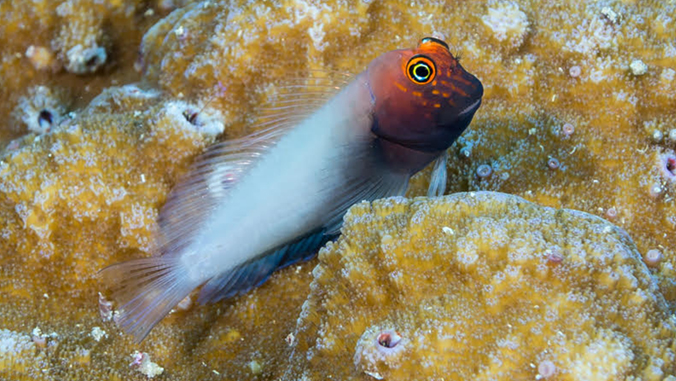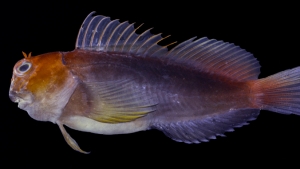
A new species of tiny fish known as the Suspiria blenny was recently discovered by a University of Hawaiʻi at Mānoa researcher. Its geographic origins and how its sister species, the Hawaiian endemic blenny, arrived in Hawaiian waters was identified in a recent study by Mykle Hoban, a Hawaiʻi Sea Grant graduate fellow and PhD candidate at the Hawaiʻi Institute of Marine Biology, and Jeffrey Williams at the Smithsonian’s National Museum of Natural History.
Hoban first collected the new species of fish on Kiritimati Island in the Republic of Kiribati. He decided to name the species Cirripectes matatakaro, which means “big eyes and burning coals” in the i-Kiribati language. Cirripectes matatakaro is most closely related to the Hawaiian endemic blenny Cirripectes vanderbilti.
“We discovered it almost by accident,” said Hoban. “We had been collecting specimens in Kiritimati of something we thought was a known species called Cirripectes variolosus. At the same time, Jeff was collecting them throughout French Polynesia. When we looked at the genetics, a certain number of the specimens turned out to be very different from the others and didn’t match any other known species of blenny. When we looked more closely and systematically at their morphology, we were able to find consistent enough differences to warrant calling it a new species.”

Hoban and Williams were limited in their geographic coverage for the widespread species, because it’s difficult to trace its location, and collecting the fish can be challenging because they are very small, skittish and quickly dive into tiny holes. Fortunately, Willams has access to a large collection of Cirripectes specimens going back decades to cover almost their entire geographic range.
They discovered that the new species had a limited distribution in the Northern Line Islands, Marquesas Islands, Tuamotu Islands, Pitcairn Islands, Gambier Islands and Austral Islands. Because the new species lives almost exclusively south and east of the Hawaiian Archipelago, they reasoned that its sister species the Hawaiian endemic blenny Cirripectes vanderbilti most likely originated from that direction rather than the Western Pacific.
“There are always new discoveries to be made in biodiversity, even among groups as well studied as fishes,” said Hoban. “This species lives in the top 5 meters of water in many places. Cryptobenthic fishes are often overlooked because they’re small and hard to find, but they have interesting biogeographical and evolutionary patterns too.”
Hoban added, “there’s still a lot to learn about reef fish biodiversity, and museum collections are extremely valuable, housing exciting discoveries waiting to be made, especially in a time when it may be difficult to track down funding for remote field expeditions.”
—By Sarah Hendrix

